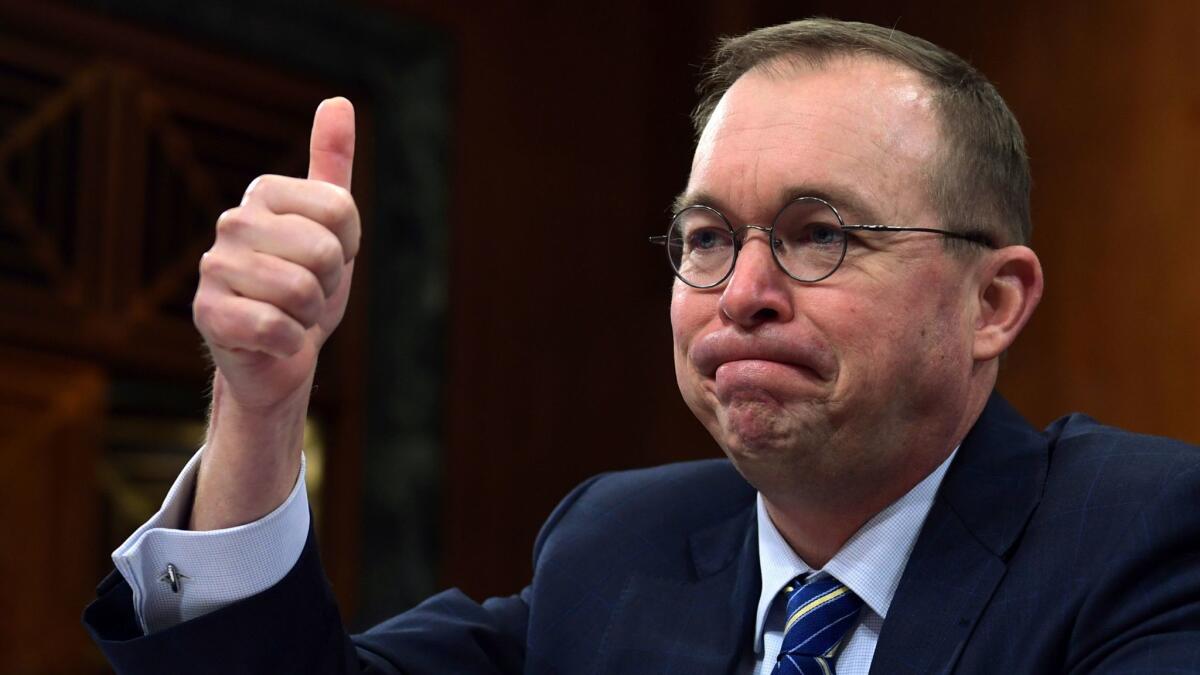Column: Economists overwhelmingly agree: Trump’s food-box idea is absurd

- Share via
The Trump administration’s idea of replacing up to half of all food stamp benefits with food boxes has been properly flayed by public assistance and nutritional specialists, members of Congress on both the Democratic and Republican sides of the aisle, and experts in food policy.
Now we have the opinion of the nation’s economists, thanks to a regular survey by the University of Chicago’s Booth School of Business. According to results published Friday, the survey’s panel of 43 economists (conservatives, progressives, and almost every shade in between) is nearly unanimous about the idea. Their conclusion: It stinks.
In fact, among economists with any opinion, it was unanimously thumbs down on food boxes.
Despite stereotypes of the incompetent poor, there is little reason to believe the government is a more efficient shopper than people.
— Yale economist Larry Samuelson
Asked whether providing cash debit cards “does more for its recipients’ well-being” than providing a smaller selection of foods directly, 29, or 67%, agreed or strongly agreed. Of the 43 panelists, only one stated that he disagreed. Another said he had no opinion, and the other 12 didn’t answer or were uncertain.
Asked in a second question whether providing benefits via debit cards allowing them to choose and buy groceries at stores “does more to raise food security and reduce hunger” than through the food boxes, 24, or 56%, agreed or strongly agreed.
That number doesn’t include MIT economist David Autor, who marked “disagree” on his ballot but told me by email that he had checked the wrong box in error. In a comment appended to his ballot, he stated, “Economic insecurity of food stamp recipients would rise if their choices were further constrained.” In other words, he agreed that the debit card method was superior. One other economist disagreed, and 17 others didn’t answer, were uncertain, or had no opinion.
As it happens, the one respondent who said he disagreed with both statements, Aaron Edlin of UC Berkeley, told me later he “misread the questions and would answer differently after rereading them.” That is, he would have agreed that food boxes were inferior to the current system of debit cards, making the feeling unanimous among economists who expressed an opinion. (Technically, the cards are “electronic benefit cards,” which work like debit cards at the checkout counter.)
As I reported earlier, the Trump administration cooked up the food box idea as part of its budget proposal for the coming year. The budget calls for replacing half of the monthly cash benefit for most recipients in the Supplemental Nutrition Assistance Program, or SNAP — to use the food stamp program’s formal name — with a Department of Agriculture food box containing “shelf-stable milk, ready-to-eat cereals, pasta, peanut butter, beans and canned fruit, vegetables, and meat, poultry or fish.”
USDA Secretary Sonny Perdue and White House Budget Director Mick Mulvaney are enamored with their cleverness; Perdue said it would be “cost-effective” and Mulvaney called the proposed change “a Blue Apron-type program where you actually receive the food instead of receive the cash.”
In fact, the change would raise costs enormously and place logistical pressures on SNAP that would be insupportable. Even Perdue, who appears to have trouble listening to his own words, acknowledged that it would cost states $2.5 billion a year to manage. That’s probably an underestimate, since nothing on this scale has been tried before.
Among other obvious drawbacks, standardized food boxes don’t leave room for allergies or religious or cultural nutritional restrictions. The very notion that the government is better placed to make food choices for families than the families themselves has been debunked at length. By whom? Among others, by the USDA, which threw cold water on a similar scheme in 2007.
As it’s currently designed, SNAP is an effective counter-cyclical economic recovery program — its benefits increase and cover more people as the economy turns sour, and shrink during recoveries. That’s what’s been happening lately, according to the Center on Budget and Policy Priorities.
“Despite stereotypes of the incompetent poor, there is little reason to believe the government is a more efficient shopper than people,” observed economist Larry Samuelson of Yale in the Chicago survey.
He’s right about the stereotype, which is related to the cherished conservative concept of the “undeserving poor.” Republicans long have had their axes poised over SNAP — House Republicans voted in 2013 to strip $40 billion from the program over 10 years, which would have thrown more than 3 million people off its rolls annually, and constantly try to legislate how recipients spend their benefits, fantasizing that they’re blowing their monthly check (average: $125.79 per person, or $4.20 a day) on lobsters and truffles.
The Trump budget said the quiet part of this scheme out loud: It set forth a plan to cut SNAP spending by one-third, or $213.5 billion, over 10 years, with about 60% of the savings coming from the boxes.
Who’s better to notice that those numbers don’t compute than a panel of economists? No wonder they turned thumbs down on this heartless and absurd scheme.
Keep up to date with Michael Hiltzik. Follow @hiltzikm on Twitter, see his Facebook page, or email michael.hiltzik@latimes.com.
Return to Michael Hiltzik’s blog.
UPDATES:
6:15 p.m.: This post has been updated to reflect that Professors Autor of Yale and Edlin of UC Berkeley did not mean to “disagree” with the proposition that food boxes are superior to debit cards, but misread the questions.



